Abstract
Appropriately substituted N-centered urazolyl radicals are capable of generating interesting cage-like structures upon forming N-N bonds. The radicals are generated by the oxidation of the corresponding NH urazole precursors. We synthesized a triurazole precursor that we hoped would dimerize through the formation of three N-N bonds to afford a large molecular cage. Unfortunately, the attempts at the oxidation of the urazoles to form urazolyl radicals instead only lead to random oligomerization, forming plastic-like materials rather than the desired cages.
1. Introduction
1-Substituted urazole radicals are a class of deeply colored persistent nitrogen-centered radicals, 2, that exist in equilibrium with the N-N dimers, 3, in solution [1,2]. The urazolyl radicals are generated from the oxidation of precursor N-H urazoles, 1, via various oxidants, including tert-butyl hypochlorite and Ni2O3 (Scheme 1) [1,2,3]. With simple alkyl or aryl substituents at the N1 and N4 positions of the urazole ring, the radical form seen in 2 remains heavily populated in the solution [1,2,3]. We have reported that for 1-aryl urazolyl radicals in which there is present a bis-ortho substitution relative to the urazole radical ring (i.e., 4) that the N-N dimer form seen in 5 predominates instead (Scheme 2) [3,4]. By leveraging this behavior, we were able to synthesize the cage compound shown by 7 via the dimerization of the triurazolyl radical seen in 6 via the formation of three N-N bonds (Scheme 3) [4]. In an attempt to form even larger cage structures in an analogous manner, we were interested in the synthesis and oxidation of a triurazole compound, as shown in 8 (Figure 1). Herein we report our synthesis, the characterization of this compound, and its attempted oxidation.
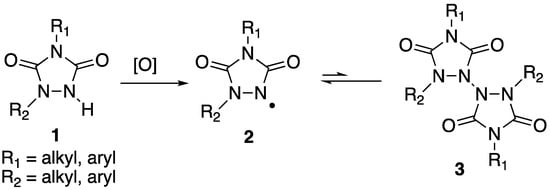
Scheme 1.
Oxidation of urazoles, 1, to form N-centered urazolyl radicals, 2, that exist in equilibrium with N-N dimers, 3, in solution.
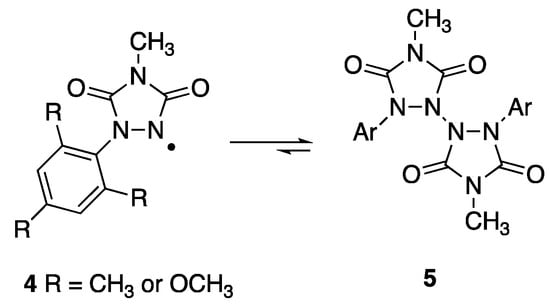
Scheme 2.
Bis-ortho-substituted 1-aryl urazolyl radicals, 4, exist predominantly in the N-N dimer form, 5, in solution.
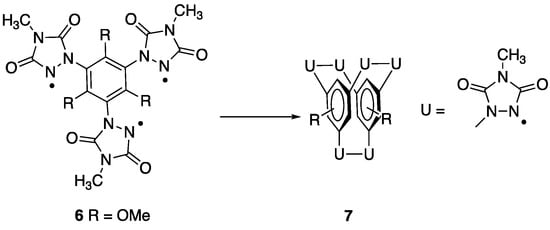
Scheme 3.
Formation of cage compound shown in 7 via the formation of three N-N bonds from the radical sites of precursor triradical, 6.
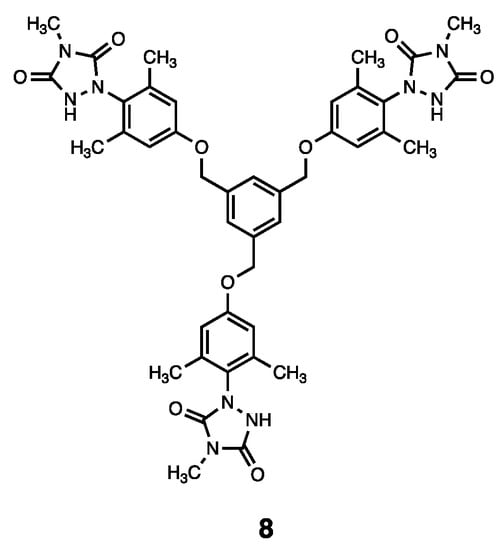
Figure 1.
Structure of target triurazole, 8.
2. Results and Discussion
Scheme 4 outlines the synthetic route utilized for the synthesis of the target molecule, triurazole, as shown in 8. The treatment of commercially available 1,3,5-tris(bromomethyl)benzene with three equivalents of the 3,5-dimethylphenoxide generated via the deprotonation of the phenol using potassium tert-butoxide afforded the known compound tris(phenoxymethyl)benzene, shown in 9, at a 96% yield [5]. Compound 9 was analyzed using 1H and 13C NMR, IR, and HRMS analyses. The NMR spectra were deceptively simple for its molecular size due to the symmetry of the structure and, in the 1H NMR spectrum, the lack of H-H coupling that meant all signals were simple singlets (see the spectra provided in the Supplementary Materials). The treatment of 9 with three equivalents of MeTAD in the presence of trifluoroacetic acid as a catalyst led to the formation of target triurazole 8 at a 98% yield. Compound 8 was characterized using 1H and 13C NMR, DEPT, IR, and HRMS analyses. As with 9, the symmetry and lack of H-H coupling rendered the 1H NMR spectrum as a simple series of singlets but with proper integrations. The N-methyl signals of the urazole rings are readily identified as a singlet at 2.99 ppm in the 1H NMR spectrum (relative integration of 6H), and the carbonyl groups of the ring appear at 153.6 and 152.5 ppm in the 13C NMR spectrum. Triurazole 8 exhibited extremely low solubility in chlorinated solvents (CHCl3, CH2Cl2) and acetonitrile but was fairly soluble in the highly polar solvents DMSO and DMF.
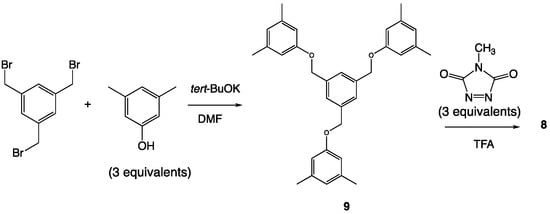
Scheme 4.
Synthesis of triurazole 8.
The oxidation of urazoles to form the corresponding urazolyl radicals can be effected by using the heterogeneous oxidant Ni2O3 in CHCl3 or CH2Cl2 [3,4]. However, attempts at oxidization in these solvents (even in boiling CHCl3) were unsuccessful, apparently due to the poor solubility of the starting triurazole. Unfortunately, DMSO and DMF, solvents that are better able to dissolve 8, were incompatible with the oxidizing agent.
The NHs of urazoles are fairly acidic, with pKa’s close to 5 [6]. Therefore, the reaction of 8 with three equivalents of NaOH in water resulted in the slow dissolution of the starting material due to the deprotonation of the urazole NHs by the hydroxide. The treatment of the resulting trianion with the oxidizing agent (NH4)2S2O8 resulted in the formation of a plastic-like material that separated from the aqueous layer. This material was also not particularly soluble in CDCl3, but from the amount that we were able to dissolve, a very complex 1H NMR spectrum that lacked the NH’s of the starting urazole 8 but included very broad signals at the remaining chemical shifts analogous to those of 8 were observed. This observation suggested that instead of forming the desired cage compound via a “dimerization” of two tri-radical units, the tri-radicals prefer to engage in oligomerization via random N-N bond formation to form the observed plastic-like material, as represented in Figure 2.
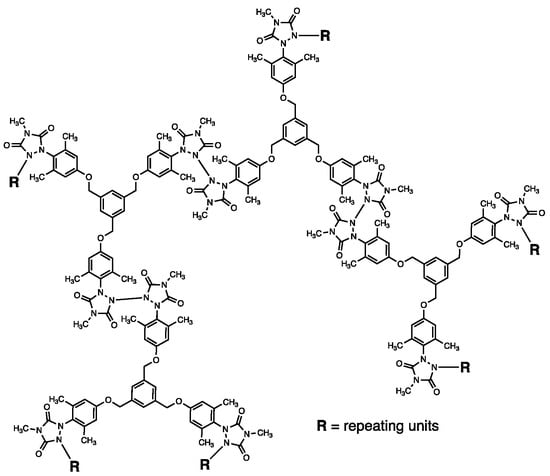
Figure 2.
Representation of plastic-like material resulting from random oligomerization of radical sites via N-N bond formation.
3. Materials and Methods
3.1. General Methods
The 1H and 13C NMR spectra were obtained using a 400 MHz NMR spectrometer. The chemical shifts were reported in units of parts per million downfield from TMS. High-resolution mass spectra (HRMS) were acquired via electron spray ionization on an LTQ-FTMS hybrid mass spectrometer. N-Methyl-1,3,5-triazoline-3,5-dione (MeTAD) was synthesized via the oxidation of N-methylurazole with DABCO-Br2, as described in the literature [7,8]. All of the other compounds were commercially available and used as received.
3.2. 1,3,5-Tris[(3,5-dimethylphenoxy)methyl]benzene (9) [5]
To a stirring solution of 2 g (0.016 mole, 4 eq) of 3,5-dimethylphenol in 50 mL dry DMF, 1.8 g (0.016 mole) of potassium tert-butoxide was added as a solid. The tert-butoxide dissolved, and the reaction mixture was stirred at room temperature for 45 min. To the resulting clear pale brown solution, solid 1,3,5-tris(bromomethyl)benzene was added at once. This mixture was stirred for 48 hours and then poured into 100 mL of ether. The organic layer was washed 3 × 50 mL 1M aq. NaOH, 1 × 50 mL sat. aq. NaCl, dried over Na2SO4, filtered, and concentrated to afford a white solid. The solid was dissolved in 80 mL of acetone, and 100 mL of methanol was then added while swirling. Crystallization began to take place almost immediately. The mixture was cooled in a freezer for 1 h, and the crystalline product was isolated via vacuum filtration to afford 1.50 g (96% yield) of 9 as colorless crystals, m.p. 129–130 °C. IR (ATR) cm−1 2916, 2862, 1617, 1596, 1325, 1298, 1174, 1160, 1084, 845, 824; 1H NMR (400 MHz, CDCl3) δ 7.46 (s, 3H), 6.62 (s, 9H), 5.05 (s, 6H), 2.29 (s, 18H); 13C{1H} NMR (100 MHz, CDCl3) δ 158.9, 139.4, 138.2, 126.0, 123.0, 112.7, 69.7, 21.6; HRMS (electron spray ionization) m/z [M+H]+ Calcd for C33H37O3 481.2737; Found 481.2745. The NMR data were consistent with the data provided in the literature [5].
3.3. 1-(4-{[3,5-bis({[3,5-Dimethyl-4-(4-methyl-3,5-dioxo-1,2,4-triazolidin-1-yl)-phenoxy]methyl})phenyl]methoxy}-2,6-dimethylphenyl)-4-methyl-1,2,4-triazolidine-3,5-dione (8)
To a stirring solution of 0.5 g of 9 (1.18 mmol) in 20 mL of CH2Cl2, 0.4 g (3.54 mmol, 3.1 eq) of MeTAD was added as a solid. To the resulting deep red solution, 0.27 mL (3.1 equiv) of CF3CO2H was added via a syringe. After stirring overnight, the resulting pale pink solution was concentrated and subjected to column chromatography (SiO2, 90:10 ethyl acetate/methanol) to afford 0.904 g (98% yield) of triurazole 9 as a white solid, m.p. 266–268 °C (decomp): IR (ATR) cm−1 1697, 1483, 1164, 857. 1H NMR (400 MHz, DMSO-d6) δ 10.8 (s, 3H), 7.51 (s, 3H), 6.87 (s, 6H), 5.16 (s, 6H), 2.99 (s, 9H), 2.13 (s, 18H); 13C{1H} NMR (100 MHz, DMSO-d6)158.7, 153.6, 151.5, 139.7, 137.5, 126.4, 125.8, 114.4, 69.1, 24.9, 17.6; HRMS (eléctron spray ionization) m/z [M+H]+ Calcd for C42H46N9O9 820.3413; Found 820.3390.
Supplementary Materials
The following supporting information can be downloaded: For compound 8: 1H NMR spectrum, 13C NMR spectrum, DEPT spectrum, IR spectrum, HRMS spectra. For compound 9: 1H NMR spectrum, 13C NMR spectrum, IR spectrum, HRMS spectra.
Author Contributions
Conceptualization, G.W.B.; methodology, G.W.B.; validation, G.W.B., J.A.B.J.; formal analysis, G.W.B., J.A.B.J.; investigation, G.W.B., J.A.B.J.; resources, G.W.B.; data curation, G.W.B., J.A.B.J.; writing—original draft preparation, G.W.B.; writing—review and editing, G.W.B.; project administration, G.W.B.; funding acquisition, G.W.B. All authors have read and agreed to the published version of the manuscript.
Funding
This research was funded by Berry College.
Data Availability Statement
Copies of spectral data for novel compounds 8 and 9 are available in the Supplementary Materials.
Acknowledgments
G.B. Thanks Berry College for financially supporting this research. We also thank Frederick Strobel, Director of the Mass Spectrometry Center at Emory University, for collecting the HRMS spectra.
Conflicts of Interest
The authors declare no conflict of interest.
References
- Gravel, P.L.; Pirkle, W.H. Non-Aryl Hydrazyls. I. Synthesis, Isolation, and Characterization of 1-α-Cumyl-4-methyurazolyl. J. Am. Chem. Soc. 1974, 96, 3335–3336. [Google Scholar] [CrossRef]
- Pirkle, W.H.; Gravel, P.L. Persistent Cyclic Diacylhydrazyl Radicals from Urazoles and Pyrazolidine-3,5-diones. J. Org. Chem. 1978, 43, 808–815. [Google Scholar] [CrossRef]
- Martin, K.L.; Breton, G.W. Computational, 1H NMR, and X-ray structural studies on 1-arylurazole tetrazane dimers. Acta Cryst. 2017, C73, 660–666. [Google Scholar] [CrossRef] [PubMed]
- Breton, G.W.; Martin, K.L. Probing the Dynamic Covalent Chemistry Behavior of Nitrogen-Centered Di- and Triurazole Radicals. J. Org. Chem. 2020, 85, 10865–10871. [Google Scholar] [CrossRef] [PubMed]
- Peng, Y.; Feng, Y.; Deng, G.-J.; He, Y.-H.; Fan, Q.-H. From Weakness to Strength: C-H/p-Interaction-Guided Self-Assembly and Gelation of Poly(benzyl ether) Dendrimers. Langmuir 2016, 32, 9313–9320. [Google Scholar] [CrossRef]
- Bausch, M.J.; David, B.; Dobrowolski, P.; Guadalupe-Fasano, C.; Gostowski, R.; Selmarten, D.; Prasad, V.; Vaughn, A.; Wang, L.H. Proton-Transfer Chemistry of Urazoles and Related Imides, Amides, and Diacyl Hydrazides. J. Org. Chem. 1991, 56, 5643–5651. [Google Scholar] [CrossRef]
- Breton, G.W.; Turlington, M. Alternative Synthetic Routes to N-Methyl-1,2,4-Triazoline-3,5-Dione (MeTAD) and Other Triazolinedione Derivatives. Tetrahedron Lett. 2014, 55, 4661–4663. [Google Scholar] [CrossRef]
- Billiet, S.; De Bruycker, K.; Driessen, F.; Goossens, H.; Van Speybroeck, V.; Winne, J.M.; Du Prez, F.E. Triazolinediones Enable Ultrafast and Reversible Click Chemistry for the Design of Dynamic Polymer Systems. Nat. Chem. 2014, 6, 815–821. [Google Scholar] [CrossRef]
Disclaimer/Publisher’s Note: The statements, opinions and data contained in all publications are solely those of the individual author(s) and contributor(s) and not of MDPI and/or the editor(s). MDPI and/or the editor(s) disclaim responsibility for any injury to people or property resulting from any ideas, methods, instructions or products referred to in the content. |
© 2022 by the authors. Licensee MDPI, Basel, Switzerland. This article is an open access article distributed under the terms and conditions of the Creative Commons Attribution (CC BY) license (https://creativecommons.org/licenses/by/4.0/).